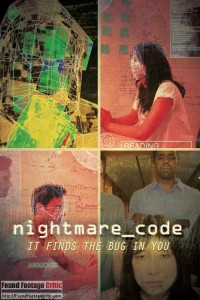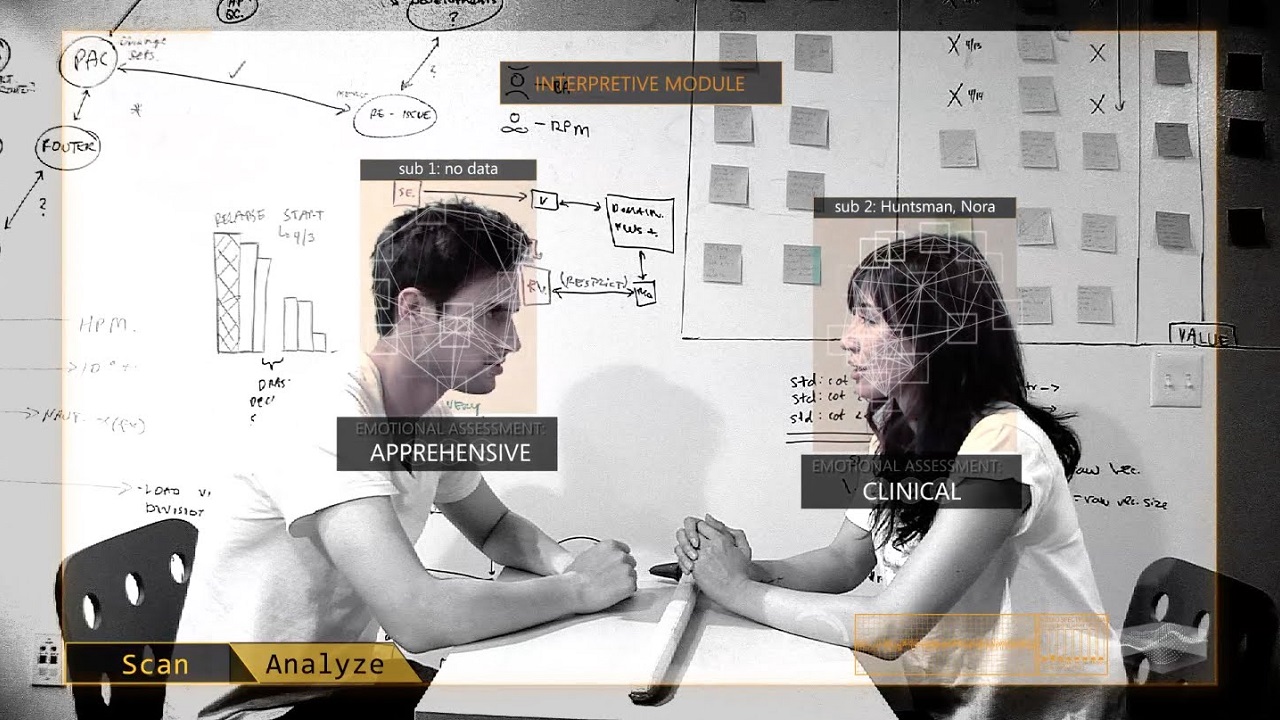 “Nightmare Code” is a sci-fi/horror found footage film written and directed by Mark Netter. The film is shot entirely from the perspective of an artificial intelligence system spying on its programmers via surveillance cameras in the corporate headquarters where the AI was created.
“Nightmare Code” is a sci-fi/horror found footage film written and directed by Mark Netter. The film is shot entirely from the perspective of an artificial intelligence system spying on its programmers via surveillance cameras in the corporate headquarters where the AI was created.
The film opens with surveillance footage of the corporate headquarters of Opt-Dex, a small high-tech startup company involved in developing an artificial intelligence system. Through surveillance footage, we see the lead developer at Opt-Dex, Foster Cotton (played by Googy Gress), on a killing spree, slaughtering his management team and then turning the gun on himself.
Next, footage of an Opt-Dex boardroom meeting reveals that the survival of Opt-Dex rides on the completion of a coding project called ROPER valued at $50 million and with a quickly approaching deadline. An outside consultant named Brett Desmond (played by Andrew J West) is brought into the company to bring the project back on track after the recent horrific events.
Brett goes on to explain that ROPER analyzes surveillance video and phone conversations to predict human behavior, for example, “whether at a fork in the road, a person will turn right or left.” The programming team at Opt-Dex is baffled by a strange phenomenon – old code bugs that the programming team fixed keep reappearing in the new code, and no one can determine why.
Given the short deadline to get to the bottom of what’s going on at Opt-Dex, Brett elects to live in the corporate headquarters, enabling him to be immersed in the project. Through his investigation, Brett starts to see a pattern emerging between the code bugs, murders, and what he finds on surveillance footage. From here, the situation at Opt-Dex quickly escalates to horrific levels.
The exceptional chemistry and acting of Andrew J. West (Brett) and Mei Melancon (Nora) provide Nightmare Code with great cohesiveness that carries throughout the film – I found myself wanting to see these two characters interact more as the film progressed
Plot and Acting
The acting in Nightmare Code comes across as real and authentic. Having personally spent the balance of my career working in information technology startups and many larger IT companies, and with some expertise in artificial intelligence, I can vouch for the validity of the dialog and manner in which the characters behave and interact – from upper management, down to the code monkeys in their cubicles and offshore development team in India. Nightmare Code does an exceptional job capturing the spirit of how a cash-strapped small tech startup might behave under the stresses of impending deadlines that could make or break the company.
The exceptional chemistry and acting of Andrew J. West (Brett) and Mei Melancon (Nora) provide Nightmare Code with great cohesiveness that carries throughout the film – I found myself wanting to see these two characters interact more as the film progressed. Other standout characters include Googy Gress (Foster), who does a great job at playing the egocentric and socially awkward programmer; Ivan Shaw (Alex) and Nicholas Guest (Ronald) as two of the executive stakeholders for the company; and Caitlyn Folley (Jennifer), as the concerned wife of Brett. These mentions are not intended to take away from the rest of the cast who also give great performances, including the programmers in the Opt-Dex headquarters, offshore team in India, and Brett’s daughter.
Towards the latter part of the film, Nightmare Code delves into plot elements that can be interpreted as either paranormal or highly advanced technology (i.e. science fiction). In either case, it’s this plot element that carries Nightmare Code through its conclusion. While the story is compelling, the CGI representation of the antagonist towards the end of the film is reminiscent of early 1990s science fiction films of the same vein, such as Lawnmower Man (1992) and Freejack (1992). This approach isn’t necessarily a bad thing, but doesn’t quite match the twenty-first century look-and-feel of the first half of Nightmare Code.
Since ROPER analyzes human behavior to predict future actions, the cameras often transition to new POVs in anticipation of where the characters will go next on screen. This approach enables Nightmare Code to flow like a narrative film, while still maintaining its found footage roots.
Found Footage Cinematography
Nightmare Code takes found footage cinematography to new heights. The film employs a dizzying array of camera sources with four split screens whose content is always changing. Each split screen contains overlaid graphics and text that show what ROPER is “thinking.” This novel approach to filming gives Nightmare Code a very high re-watch value. There’s so much information presented to the viewer at any given moment that it’s impossible to catch everything going on. Despite the data overload, viewers will not feel like they’ve missed anything – going back and watching Nightmare Code multiple times will only enhance their experience, providing more insight into ROPER’s mindset and visual cues from different POVs that the viewer may have missed the first time around.
Nightmare Code employs interesting cinematography that’s only made possible through the unique plot of the film. Since ROPER analyzes human behavior to predict future actions, the cameras often transition to new POVs in anticipation of where the characters will go next on screen. This approach enables Nightmare Code to flow like a narrative film, while still maintaining its found footage roots. In a found footage film, we often have to ask “why” the camera POV transitions to this view or that. In the case of Nightmare Code, the answer is simple, the camera angles switch because that’s where ROPER wants to look.
The shear level of detail overlaid on the surveillance footage is also very informative and fun to watch and read – providing insight into ROPER’s intentions and thinking. The on-screen overlays are brilliant, adding depth and dimension to the film and viewer experience. As mentioned earlier, Nightmare Code has high re-watch value as it’s virtually impossible to take in all of the information provided in one viewing.
While Nightmare Code does a great job with cinematography, the film does include one of my found footage pet peeves, the inclusion of background music and overt sound design in specific scenes to ratchet up the tension. Pure found footage normally would not contain any soundtrack unless one of the characters creating the found footage subsequently added the audio during editing.
Filming Reason
The filming reason in Nightmare Code is nothing short of perfect, as the entire film consists of surveillance footage captured and recorded by ROPER as part of the systems programming.
Nightmare Code has high re-watch value as it’s virtually impossible to take in all of the information provided in one viewing.

